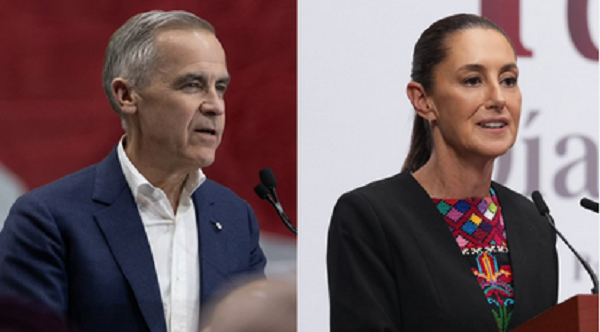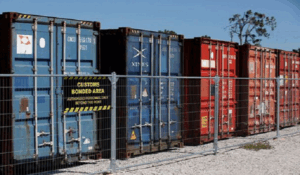Carney, Sheinbaum reach a deal to start working more closely together in face of U.S. tariffs
Prime Minister Mark Carney and Mexican President Claudia Sheinbaum have agreed to immediately start working more closely in the face of U.S. President Donald Trump’s tariffs and the looming renegotiation of the pact that governs continental free trade.
So far, Canada and Mexico do not appear to have co-ordinated much on the file, despite suffering the same attacks in Mr. Trump’s trade war and being broadly aligned on preserving open markets between the three countries.
Canada-Mexico co-operation has a fraught history, mostly related to tensions in both countries over whether to stick together or seek separate deals with the United States in a bid to mollify Mr. Trump.
Mr. Carney and Ms. Sheinbaum spoke by phone on Thursday. In a summary of the call, the Prime Minister’s Office said the pair assigned “senior officials to immediately work to find opportunities to deepen bilateral relations” via the U.S.-Mexico-Canada Agreement, or USMCA.
“We’re going to protect that critical partnership in the face of global economic shocks,” Mr. Carney wrote on X. Ms. Sheinbaum tweeted that she congratulated Mr. Carney on his election victory and “we agreed on the importance of the USMCA for the three nations.”
Neither Mr. Carney’s nor Ms. Sheinbaum’s offices responded to requests for more detail.
One senior Mexican official said that in recent months the two governments have mostly only exchanged pleasantries on trade and have not been working together on a common front. The source suggested this was mostly because of the Canadian election.
The Globe and Mail agreed not to name the official in order to learn details of behind-the-scenes discussions.
Intergovernmental Affairs Minister Dominic LeBlanc, the point-man on Canada-U.S. relations, declined an interview request on the government’s co-ordination with Mexico. “It is still too early to discuss this matter publicly,” his spokesman, Gabriel Brunet, wrote in an e-mail.
Mr. Trump earlier this year hit Canada and Mexico with blanket tariffs on anything not traded under the USMCA, the first major salvo in a trade war he has since expanded globally. The two countries are also disproportionately affected by Mr. Trump’s worldwide tariffs on steel, aluminum and autos.
USMCA comes up for review next year and Mr. Trump has said he wants to extensively renegotiate it. In a White House meeting with Mr. Carney last week, Mr. Trump also suggested he might do away with the deal entirely.
On Friday, Mr. Trump cryptically suggested that more worldwide tariffs may soon be coming. Next week, he said, his treasury and commerce secretaries “will be sending letters out” telling countries “what they’ll be paying to do business in the United States.” Speaking during a trip to the United Arab Emirates, he did not elaborate.
Emilio Cadena, CEO of Grupo Prodensa, a Mexican company that helps foreign corporations set up shop in Mexico, said USMCA’s two smaller partners have to stand firm on keeping the agreement trilateral.
It is in their mutual interest to ensure that all three countries in the pact are treated the same. In USMCA negotiations in 2017 and 2018, for instance, Mr. Trump unsuccessfully pushed for a guaranteed percentage of all car parts in North America to be made in the U.S.
“On some of these principles, we have to be fighting for the same cause, so these things have to be co-ordinated,” said Mr. Cadena, who helped advise Mexican negotiators during the talks that led to the USMCA.
He noted that the Canadian and Mexican private sectors are already working closely together, with particular collaboration between the Business Council of Canada and the Consejo Coordinador Empresarial, a major Mexican business lobby.
In January, for instance, the two groups held a joint meeting with Ms. Sheinbaum and her economy minister, Marcelo Ebrard, along with representatives from a host of major Canadian and Mexican companies, including Bank of Nova Scotia, Canadian National Railway, Linamar, TC Energy, WestJet, Grupo Bimbo and Aeroméxico.
Ontario Premier Doug Ford has floated the idea of kicking Mexico out of the USMCA to assuage Mr. Trump’s concerns over the country being used as a back door for Chinese auto parts to enter the U.S. But the pitch appears to have gained Canada nothing with Mr. Trump, who has treated Ottawa the same as Mexico City.
The senior Mexican official said that while the country’s government is scared about what further damage Mr. Trump may visit upon its economy, the White House has indicated to Mexico that it prefers that the USMCA remain a trilateral deal, albeit with major changes.
The official said Mexico is not likely to retaliate against Mr. Trump’s tariffs because so much of the country’s trade involves intermediate goods – car parts, for instance – that tariffing imports would hurt Mexican production too much to be worth it.
Canada has taken the opposite approach, imposing retaliatory tariffs on the U.S. in a bid to increase domestic pressure on Mr. Trump to back off his trade war.
Ildefonso Guajardo, a former Mexican economy minister who oversaw USMCA negotiations during Mr. Trump’s first term, said his close relationship with Chrystia Freeland, the then-foreign affairs minister who led talks for Canada, was key during negotiations.
The two countries successfully pushed back on U.S. demands to strip out nearly all of the deal’s enforceability provisions, for instance, as well as Mr. Trump’s demand for guaranteed U.S. content in all North America-made cars.
“The strategy of the U.S. was to bilateralize things – divide and conquer. Chrystia and I always exchanged information on areas where Canada and Mexico had common interests,” he said.
While the two countries did deal separately with the U.S. later in the negotiations – leading to a fractious meeting at the Canadian embassy, as The Globe reported at the time – the ultimate deal mostly preserved barrier-free trade on the continent.
Mr. Guajardo said that his understanding currently is that there has been Mexico-Canada contact at the level of career officials but little co-ordination at the ministerial level. “We need much more interaction and co-ordination than there is. We need the top level to get close in this.”
Mr. Guajardo also argued in favour of sharper retaliation on Mr. Trump for violating the USMCA with the tariffs.
“The countries that have responded aggressively are the ones that have a seat at the table. With China, he had to do the moonwalk back and back and back,” he said, referring to Mr. Trump’s abrupt scaling back of tariffs on Beijing after the country hit back hard with tariffs of its own. “He will not treat you with respect unless you respond.”
This article was first reported by Reuters














